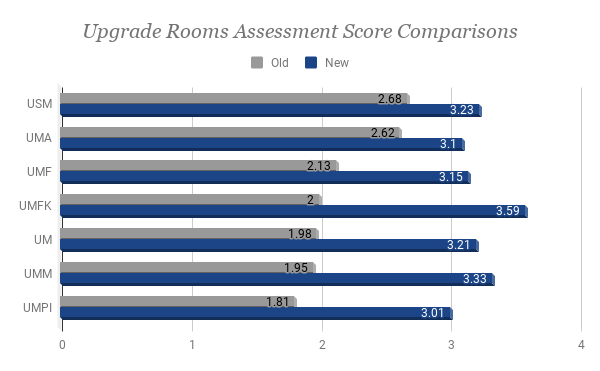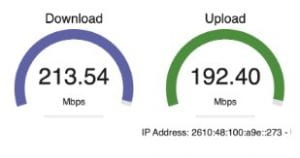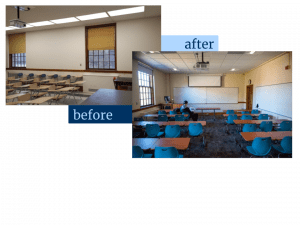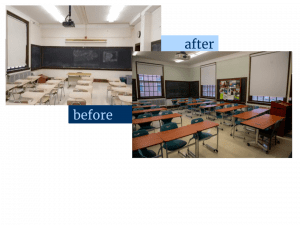CLASSROOMS FOR THE FUTURE PROJECT | MAINESTREET IMPROVEMENTS: CS 9.2 UPGRADE | MAINESTREET IMPROVEMENTS: UX PROJECT | STATE OF IT RUS GRANT | UMF-TELEPHONE SYSTEM REPLACEMENT | WIRELESS INFRASTRUCTURE
CLASSROOMS FOR THE FUTURE PROJECT
The Classrooms for the Future (CFTF) project was awarded a total of $4,945,075 in funds for upgrading classrooms and classroom technology systems. The CFTF team worked with campus administration, faculty and staff to identify spaces needing technology upgrades and, in some cases, facility-related treatment.
Summer 2019 upgrades completed the bulk of the Classrooms for the Future Project, Phase 1, with just a few remaining projects that will occur during winter break. Overall, classroom upgrades over the last four years have been met with a great deal of positive feedback from faculty and students. Instructional designers are working with members of the CFTF team to gather data on how newly added active learning spaces and upgraded rooms are impacting teaching and learning.
During Summer 2019, the CFTF team managed and installed 50+ classroom technology systems across the University of Maine System. In addition, the Classroom Technology team, the workforce behind the project, installed systems that were identified and paid for by the campuses. As part of the Summer 2019 CFTF upgrades, the University of Maine at Presque Isle and Houlton Higher Education Center installed web conferencing systems in two classrooms and participated in a pilot program for integrating Zoom software based conferencing with video conferencing hardware. The pilot took place during the fall semester, and additional equipment will be installed in two other classrooms over winter break.
The CFTF project in total has been able to fully upgrade 246 classroom technology systems across the UMS. Overall, 44% percent of the rooms throughout UMS have been completed, leaving 313 classrooms still in need of upgrades. The percentage of rooms that were completed per campus varied depending on the initial state of identified rooms and on the campus’s ability to provide supplemental funds for the work. The few projects remaining on the UMA, UMM, UMPI and USM campuses will be completed during winter break.

All rooms that have been completed with Classrooms for the Future funding have been reassessed to account for upgrades in equipment and/or facilities-related work. Reassessments have revealed marked improvement in scores. The overall average score for UMS classrooms prior to upgrading was 2.17 while the new score is 3.20.
Throughout the project, information about classroom environments and technology has been gathered, maintained and populated into a database. This data includes the type of room, equipment installed, photographs, and ongoing assessment scores. Maintenance information will also be added in the near future along with “how-to” documentation to assist users with equipment on all campuses.
MAINESTREET IMPROVEMENTS: CS 9.2 UPGRADE
 The Campus Solutions (CS) 9.2 Upgrade project kicked-off in late October 2018 and was completed during the first week of June 2019. The project achieved its objectives in upgrading the MaineStreet Campus Solutions system from version 9.0 to version 9.2, the CS PeopleTools from version 8.55 to version 8.56, and migrating the CS environments from the legacy Solaris architecture to Linux architecture.
The Campus Solutions (CS) 9.2 Upgrade project kicked-off in late October 2018 and was completed during the first week of June 2019. The project achieved its objectives in upgrading the MaineStreet Campus Solutions system from version 9.0 to version 9.2, the CS PeopleTools from version 8.55 to version 8.56, and migrating the CS environments from the legacy Solaris architecture to Linux architecture.
Given the project’s aggressive timeline, a key factor in the project’s overall success was the thorough vetting of the project’s scope and the strong support by UMS leadership at all levels. That, combined with a deep commitment by all project team members, technical and functional, enabled the project to be successfully delivered in scope, within budget, and on time.
MAINESTREET IMPROVEMENTS: UX PROJECT
MaineStreet Campus Solutions is our Student Information System (SIS) that manages student data. Typical functions include registering students into courses, recording official grades, producing transcripts, student financial aid, and much more. Although MaineStreet Campus Solutions handles large amounts of complex data very well, the user interface and experience, especially for faculty and students, is far from ideal and lacks a contemporary look/feel especially when accessing the system via a mobile device.
On the heels of the CS 9.2 Upgrade Project is the upcoming deployment of 3rd party interface enhancement tools during the 2019-2020 Academic Year. UMS is partnering with HighPoint Technology Solutions to deliver seamless integration points which are intended to greatly improve the student and faculty experience within our Student Information System.
| Current MaineStreet Look/Feel | Highpoint UX/UI Enhancement |
As the User Experience (UX) project continues to ramp up towards a phased rollout and full deployment, we offer a peek into some visuals of the improved experience. Please note, the visualizations included in this State of IT Report are conceptual representations of the transformation capabilities. The actual look, feel, and design will be determined with broad input from faculty, students, and other key stakeholders.
STATE OF IT RUS GRANT
The University of Maine System was awarded a USDA Rural Utilities Service Distance Education and Telemedicine grant. The project, 21st Century Education: Modernizing Distance Education for Rural Maine, will convert both it’s video conferencing and instructional television 20th century distance education systems to a new 21st century web conferencing solution. Sixty two sites, centers and campuses across the State of Maine will receive upgraded equipment as a result of this award.
The grant allows for the conversion to web conferencing equipment and will provide an opportunity for the University of Maine System to meet the growing demand for shared programming through increased cross-campus collaboration. The project will enable students at smaller institutions and outreach centers to benefit from a broader availability of classes in such areas as the STEM disciplines, foreign languages, and nursing. Rural entrepreneurs, teachers and other professionals may also benefit as the added system capacity allows for educational programming that meets their needs while linking them to peer and professional networks.
The solution will provide a unified teaching and learning experience combined with remote services and support that is ideally suited for rural Maine students.
UMF – TELEPHONE SYSTEM REPLACEMENT
On Feb. 4, 2019 the Avaya phone switch that has served UMF since the early 1990s stopped processing calls. The switch could not read the file that contained its licensing information so calls could not be handled. In consulting with Avaya resellers it became clear that, due to the age of the phone switch, there was no way to recreate the licensing file. Fortunately, in the late afternoon of the same day, the phone switch was suddenly able to read its license file and started processing calls again. The crisis, while not averted, was at least postponed.
US:IT immediately kicked off efforts to put a plan in place for handling another failure of the phone system. This near term plan would take into account the existing longer term plan to move the campus off the Avaya phone switch to Voice over IP (VoIP) which is used throughout the University System. The US:IT Support Services and Networkmaine teams were joined by representatives from campus administration and facilities management to identify priorities, challenges, and options.
The resulting action plan called for installing a number of large analog voice gateways that support connecting standard analog phones to the IP network alongside the existing Avaya phone system. Life-safety related and other priority phones were the first to move to the gateways so that the campus would maintain critical phone services if/when the Avaya system were to suddenly fail again.
Together US:IT Support Services and Networkmaine identified and converted the high priority phones in short order.
From there, the teams worked together to create an inventory of the Avaya phone system’s approximately 1,600 digital and analog ports, detailing how each was configured, what they were used for, and where the phone or other device connected to it was located on the campus. Along with this port inventory a catalog was created to document what needed to be done in each building to prepare it for VoIP. US:IT Support Services and Networkmaine staff developed deployment procedures and schedules and have spent the past 10 months working together to move the campus to VoIP building by building.
| BUILDING | % COMPLETED |
| 101 South | 100% |
| 114 Prescott | 100% |
| 144 Quebec | 100% |
| 149 Quebec | 100% |
| Admissions | 2% |
| Alumni Theater | 100% |
| Black | 100% |
| Brinkman House | 100% |
| Dakin | 100% |
| Dearborn Gym | 100% |
| Education Center | 100% |
| Emery Arts | 100% |
| Facilities Mgmt | 100% |
| Ferro House | 4% |
| Franklin Hall | 4% |
| FRC | 0% |
| Fusion Center | 100% |
| Honors | 100% |
| Lockwood | 100% |
| Look | 100% |
| Mallett | 100% |
| Mantor | 100% |
| Merrill Hall | 4% |
| Olsen Student Center | 22% |
| Preble Hall | 100% |
| Psychology Building | 100% |
| Ricker Addition | 100% |
| Ricker Hall | 100% |
| Roberts Hall | 100% |
| Scott S | 100% |
| Scott W | 100% |
As of December 2019, roughly 80% of the buildings at UMF have been converted to VoIP. Most of what remains are buildings that require new structured-cabling in order to support VoIP. The remaining work is on track to be completed by the summer of 2020. Thanks to the collaborative and “can do” attitude of both the Support Services and Networkmaine teams, the conversion of UMF to VoIP will be the fastest conversion since UMFK 15 years ago.
WIRELESS INFRASTRUCTURE

The Wireless Infrastructure Project represents a $12.8M investment intended to upgrade wireless service and associated cabling and equipment at all campuses to bring wireless capacity to support gigabit speeds to a subset (roughly 50%) of buildings across the System. The focus of this project is on upgrading learning and living spaces. The project has successfully addressed the majority of such spaces across the System. As the project winds down, what remains is the balance of the learning and living spaces along with administrative, research, and athletic spaces.
Work on this project continues with the final $2M in upgrades scheduled for the remainder of the 2019-2020 year. At the end of this project, a total of 73 academic buildings and 17 residence halls will have been updated over a four year time span.
Every day, approximately 20,000 devices connect to the wireless networks across the University System consuming over 4,000 Mbps on most days. The use of the eduroam service has continued to grow.
In the month of October 2019 alone we connected 2,017 visitor’s devices coming from 162 locations, including 26 countries while 1,193 of our faculty, staff and students have visited 180 locations, including 21 countries.
A key performance indicator is that the percentage of wireless access points and network switches that are in use, but beyond the supported lifespan. While new network equipment has been deployed through the project, the number of devices that have surpassed their supported lifespan continues to increase overall as several equipment models have aged out. As of Fall 2019, only 62% of network switches and 92% of Access Points presently installed are considered “current generation”. By the end of 2023 these numbers drop to 26% of network switches and 73% of Access Points.
The sheer amount of outdated network equipment still in use increases the risk of network instability (failing equipment), security vulnerabilities (security patches are no longer being released), and the amount of time and effort needed to support the network.
WHAT REMAINS
At the conclusion of this project roughly 50% of UMS facilities still require significant investments to meet modern day expectations. Networkmaine estimates it will require $13 million to upgrade the remaining facilities. Roughly $7 million of the total is required for facilities and structured cabling work to prepare buildings to support current generation Wi-Fi. The remaining $6 million is required for network electronics to provide the Wi-Fi service.



